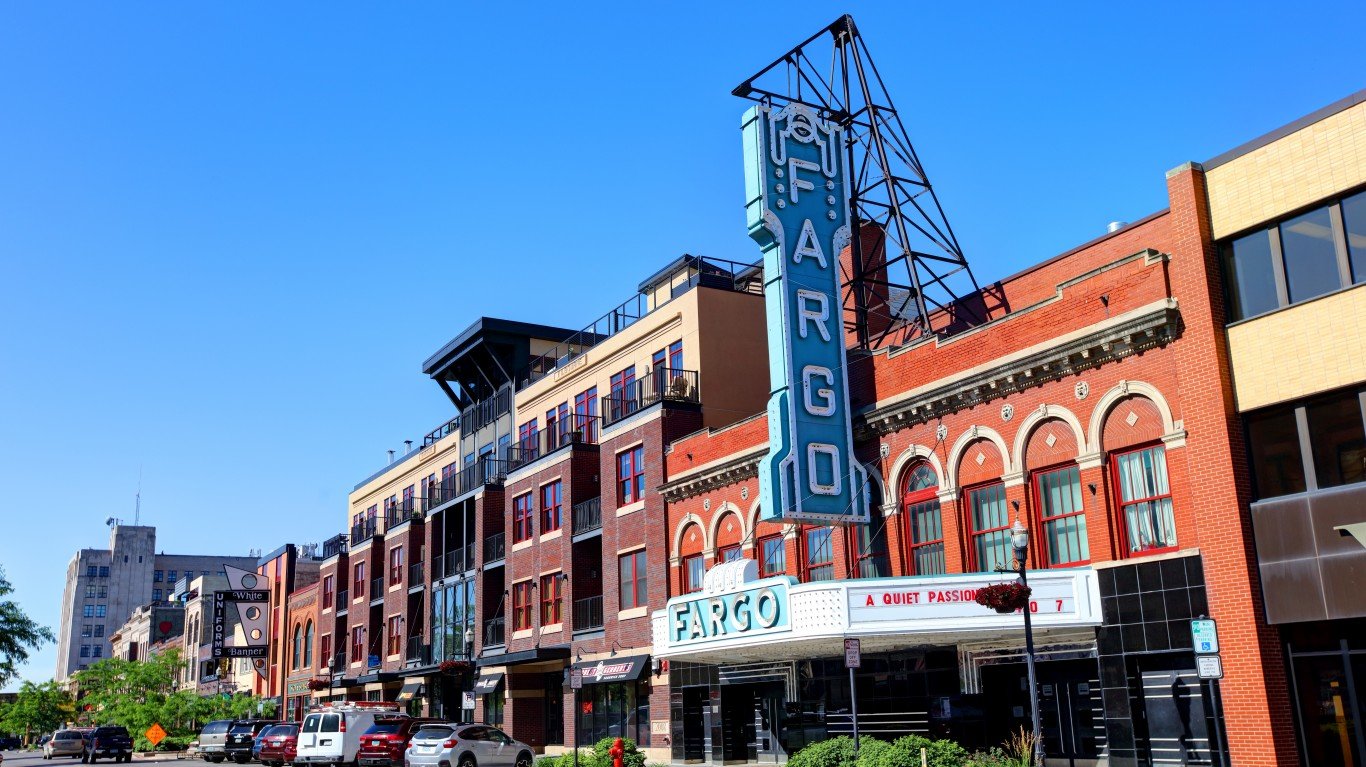

Per capita income in the United States rose by 1.8% in 2017 to $48,684 in 2017, the third straight annual increase. Per capita income growth was seen all across the country, and while per capita incomes rose more in some metro areas than others, they rose in nearly every U.S. metropolitan area.
Some metropolitan areas, however, bucked the national trend, and there are even a few areas — less than a dozen — where per capita personal income declined by 1% or more. Based on per capita annual incomes released by the Bureau of Economic Analysis, 24/7 Wall St. reviewed the 10 cities where incomes are shrinking the fastest.
In most of the cities where per capita per capita incomes declined in 2017, the declines followed recent income booms. For example, per capita income in Midland, Texas, declined for the third straight year in 2017, including a 25.6% decrease in 2015. In 2010 and 2011, however, per capita income in the Texas metro area increased by 14.8% and 30.4%, respectively.
In the case of Midland, and of many cities on this list, the recent per capita income declines are likely due to the correction in the oil market after prices fell in in 2014 and 2015. In fact, Midland still has one of the highest median household incomes in the country. Here is the full list of America’s richest cities.
While per capita incomes have declined in these places, these cities by no means have weak economies. Unemployment rates in most of the cities on this list remain low — in 9 of the 10 cities, the May unemployment rate was below the national rate of 3.6%. In these 10 metropolitan areas, per capita incomes have likely fallen in large part due to population increases, rather than substantial wage declines. Several of the metro areas on this list are among the fastest growing U.S. cities. These are America’s fastest growing cities.
Click here to see the 10 cities where incomes are shrinking the fastest
Click here to read our methodology

10. Tyler, TX
> Per capita income change in 2017: -0.9%
> 5 yr. per capita income change: -6.0%
> Per capita income: $47,677
> May 2019 unemployment: 2.8%
After per capita incomes in Tyler rose by 6.5% in 2010 and by 9.1% the following year — some of the fastest income growths among metro areas during that period — the trend reversed. In the past three years, per capita personal income fell by 7.9% in 2015, 2.4% in 2016, and 0.9% in 2017. Tyler’s recent income declines are likely due in large part to the metro area’s reliance on the oil and gas industry, which took a hit following the decline in oil prices in 2014 and 2015. Employment in the sector, which includes oil extraction, declined by 43% through the five years ending in 2017.
[in-text-ad]

9. Amarillo, TX
> Per capita income change in 2017: -1.0%
> 5 yr. per capita income change: +2.1%
> Per capita income: $44,588
> May 2019 unemployment: 2.1%
Amarillo, along with Midland and Tyler, is one of three Texas cities that had one of the 10 largest declines in personal per capita income from 2016 to 2017. The city’s per capita income dropped from $45,059 to $44,588 in that period — a 1.0% decline. Amarillo’s per capita income is over $1,500 less than Texas’ income per person, even though the city has one of the lowest unemployment rates of any city in the country at 2.1%. The U.S. unemployment rate for May 2019 is 3.6%.

8. Bismarck, ND
> Per capita income change in 2017: -1.2%
> 5 yr. per capita income change: +1.4%
> Per capita income: $55,754
> May 2019 unemployment: 2.2%
As the per capita income rose and fell in Bismarck, so did the population. The city, along with the rest of North Dakota, experienced an economic boom in the last decade thanks to oil exploration in the Bakken Shale. People flocked to the state for high-paying jobs, and the income per capita swelled from less than $45,000 in 2008 to a peak of $57,355 in 2015. As oil prices declined starting in 2014, oil production in the Bakken Shale also fell, as did incomes. Income per capita in dropped by 1.6% in 2016 and 1.2% in 2017.

7. Champaign-Urbana, IL
> Per capita income change in 2017: -1.4%
> 5 yr. per capita income change: +3.0%
> Per capita income: $45,240
> May 2019 unemployment: 3.4%
Champaign-Urbana has had a dramatic increase in the share of its residents living below the poverty line over the past few years. In 2012, the area’s poverty rate of 11% was lower than the U.S. poverty rate of 12%. By 2017, Champaign-Urbana’s poverty rate rose to 19%, well above the U.S. poverty rate of 13.4%. 2017 was the second year per capita income declined in Champaign-Urbana. The decline of 1.4% in 2017 followed the 1.8% drop the year prior.
[in-text-ad-2]

6. Fargo, ND-MN
> Per capita income change in 2017: -1.5%
> 5 yr. per capita income change: +3.9%
> Per capita income: $52,534
> May 2019 unemployment: 2.1%
Though Fargo has one of the lowest unemployment rates in the country at 2.1%, its per capita income is still slipping. Fargo’s per capita income soared beginning in 2010, when the per capita income was $45,388. By 2015, per capita income rose by nearly $8,000. Incomes remained relatively stagnant in 2016, then decreased significantly. Per capita incomes then dropped from $53,348 in 2016 to $52,534 in 2017, a 1.5% decline. Fargo is one of just six places in the country where incomes fell by 1.5% or more.

5. Greeley, CO
> Per capita income change in 2017: -1.6%
> 5 yr. per capita income change: +9.6%
> Per capita income: $42,196
> May 2019 unemployment: 2.2%
Incomes in Greeley, Colorado, have been among the most volatile in the country over the past decade. In 2009 and 2010, Greeley’s per capita incomes shrank. For the next four years, per capita income growth far outpaced the growth nationwide, peaking in 2014 with 7.0% growth. In 2015, Greeley’s per capita income growth of 3.3% lagged slightly behind the U.S. income growth of 3.8%. In both 2016 and 2017, Greeley’s per capita income fell by 1.6%. Despite the recent decline, the town’s five-year per capita income growth has slightly outpaced that of the U.S. overall. Home prices in Greeley soared 50% from 2012 to 2017, one of the largest increases of any city.
[in-text-ad]

4. Sioux Falls, SD
> Per capita income change in 2017: -1.8%
> 5 yr. per capita income change: +9.0%
> Per capita income: $57,955
> May 2019 unemployment: 2.4%
Though Sioux Falls, South Dakota, had one of the largest per capita income drops in 2017, area residents do not appear to be struggling financially. The city’s income per capita is just shy of $58,000, well above the state income per capita of $52,141 and the U.S. income per capita of $48,684. The poverty rate in Sioux Falls has also declined from 7.4% in 2012 to 6.8% in 2017 — the fourth lowest poverty rate in any U.S. city considered. Comparatively, the U.S. poverty rate increased from 11.8% to 13.4%.

3. Sioux City, IA-NE-SD
> Per capita income change in 2017: -2.4%
> 5 yr. per capita income change: +8.1%
> Per capita income: $51,455
> May 2019 unemployment: 2.2%
The per capita income in Sioux City for 2017 was $51,455, almost exactly what was in 2008. From 2008 to 2011, the city’s income per capita dropped from over $51,000 to below $47,000 before rebounding to $52,698 in 2016, then dropping 2.6% to $51,455 in 2017. Sioux City residents may have a hard time finding high-paying jobs due to low educational attainment rates in the city. Just 22.1% of adult residents held a bachelor’s degree or higher as of 2017, nearly 10 percentage points below the U.S. bachelor’s degree attainment rate.

2. Midland, TX
> Per capita income change in 2017: -2.8%
> 5 yr. per capita income change: -36.3%
> Per capita income: $70,133
> May 2019 unemployment: 1.7%
Midland’s 2.8% decline in per capita income is actually an improvement compared to the previous two years. In 2016, the city’s per capita income fell by 15.7%, and it fell by 25.6% the year before that — both the highest percentage point declines of any U.S. city. Per capita income in Midland, which relies on the oil and gas industry to fuel its economy, has seesawed over the past decade. The city led the nation in per capita income growth in 2010 and 2011 with 14.8% and 30.4% growth, respectively. From 2012 to 2017, per capita incomes in Midland have declined more than anywhere else in the country. In that period, Midland’s per capita income fell from over $111,000 to just over $70,000, a 36% decline. Despite the large drop, per capita incomes in Midland are well over the $48,684 per capita income.
[in-text-ad-2]

1. Jacksonville, NC
> Per capita income change in 2017: -3.5%
> 5 yr. per capita income change: +2.8%
> Per capita income: $46,155
> May 2019 unemployment: 4.8%
After having one of the fastest growing per capita incomes in 2016, Jacksonville, North Carolina, had a sharp drop in per capita income the following year. From 2015 to 2016, the per capita income of the area grew by 6.4%, the second highest rate of anywhere in the country. Just a year later, per capita income declined by 3.5% — the largest drop as no other city had more than a 3.0% decline. Jacksonville’s personal per capita income of $46,155 is over $2,500 below the U.S. income per capita. This may be due in part to the city’s relatively high unemployment rate of 4.8% as of May 2019, a time when the U.S. unemployment was 3.6%.
Methodology
To identify the cities where incomes are shrinking the fastest, 24/7 Wall St. reviewed the largest real personal income per capita declines in 2017 among the nation’s 382 metropolitan statistical areas with data from the Bureau of Economic Analysis. Real personal income figures also came from the BEA. The BEA’s income figures for each year starting in 2008 were reviewed as well, all adjusted for inflation, chained to 2012 dollars. The share of each MSA’s workforce employed in each industry in 2015, 2016, and 2017 as well as average wages by industry for each MSA, came from the Quarterly Census of Employment and Wages, a program of the Bureau of Labor Statistics. Unemployment rates also came from the BLS. Population growth, median household income, poverty rates, the percentage of households earning at least $200,000 and less than $10,000, and SNAP recipiency came from the 2017 American Community Survey.
Sponsored: Want to Retire Early? Here’s a Great First Step
Want retirement to come a few years earlier than you’d planned? Or are you ready to retire now, but want an extra set of eyes on your finances?
Now you can speak with up to 3 financial experts in your area for FREE. By simply clicking here you can begin to match with financial professionals who can help you build your plan to retire early. And the best part? The first conversation with them is free.
Click here to match with up to 3 financial pros who would be excited to help you make financial decisions.
Thank you for reading! Have some feedback for us?
Contact the 24/7 Wall St. editorial team.
 24/7 Wall St.
24/7 Wall St. 24/7 Wall St.
24/7 Wall St.
